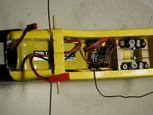
I've experimented with several different battery types and sizes to
improve the performance of my airplanes. To read about basic battery
types, refer to my battery info page.
I started out with the 150mAh 6-cell packs that come with the GWS Naro
or Pico electronics kits. The Tiger Moth flight times were about 5
minutes and for the last minute or two the Tiger Moth would have
problems gaining altitude.

I bought a 270mAh GWS battery to extend the flying time. But then I found that the battery compartment wasn't large enough to hold this battery! So out came the rotary tool and razor knife to enlarge the battery compartment. To make the plane balance correctly, the battery has to be positioned back into the electronics cavity as shown.
The next thing I did was to expand the 7.2-volt (6-cell) GWS 270mAh pack to a 7-cell pack by adding a spare battery that I had on hand. It isn't a good idea to mix batteries of different ages, but I figured it was worth an experiment. The Tiger Moth performs much better with the 7-cell pack. Loops are easier to perform and it climbs easier. Adding the cell increases the pack voltage to 8.4 volts and therefore the motor RPM. Adding this cell does not increase the pack capacity nor the flying time. It weighs 89 grams (3.1 oz).
In this photo, I show all the battery packs I've used with my Tiger
Moth.
 From the top down:
From the top down:
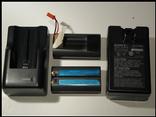 I purchased two Sony QN-012BC Lithium Ion batteries with
chargers from American Science &
Surplus. These are 7.2-volt 1200mAh battery packs. They won't
generate the high RPM that the 7-cell packs have, but should run for a
long time. I've modified one pack to add the JST connector and still
allow it to charge directly from the charger. This is the same
battery pack and charger that is advertised by Batteries America.
I purchased two Sony QN-012BC Lithium Ion batteries with
chargers from American Science &
Surplus. These are 7.2-volt 1200mAh battery packs. They won't
generate the high RPM that the 7-cell packs have, but should run for a
long time. I've modified one pack to add the JST connector and still
allow it to charge directly from the charger. This is the same
battery pack and charger that is advertised by Batteries America.
A more recent modification is to solder some leads for a 2-pin DEANS micro connector (very good connectors that handle high current) directly to the pins on the charger. I lay a 2-cell LiIon pack into the cradle of the charger, hold it down with a rubber band, connect it to the DEANS connector, and plug it into the wall. This charger will charge the cells up to 8.4 volts. However, it does not do the final charge where the current tapers off to .050A while keeping the voltage constant. I discovered this when one of the packs didn't fly my Piccolo helicopter very well. I recharged the pack on the Sony charger, then moved it to my Orbit. The Orbit added another 65mA to the pack. That doesn't seem like a lot, but it seems to make a difference in how the helicopter performs.
Safety Note:Lithium Ion batteries must be charged from a special charger to prevent them from exploding or emitting very hot gasses or flames. A charger for NiCd or NiMh batteries won't be safe. My modification uses the charger that comes with the batteries and does not modify the battery protection circuits or charger.
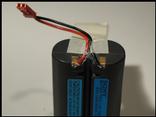 I used my rotary tool to engrave two grooves in the bottom of the
battery pack and soldered a JST connector to the back of the
connections. After soldering the connections, I glued the wire into
the grooves with CA. The grooves are necessary to recess the wire
enough to allow the battery to sit low enough in the charger to engage
the safety interlock on the charger. I added velcro to hold the
battery in the Tiger Moth and masking tape as a tab to aid removing
the battery from the battery compartment.
I used my rotary tool to engrave two grooves in the bottom of the
battery pack and soldered a JST connector to the back of the
connections. After soldering the connections, I glued the wire into
the grooves with CA. The grooves are necessary to recess the wire
enough to allow the battery to sit low enough in the charger to engage
the safety interlock on the charger. I added velcro to hold the
battery in the Tiger Moth and masking tape as a tab to aid removing
the battery from the battery compartment.
The Lithium Ion pack that came with the Sony chargers don't have much capacity. The LiIon cells from Electronic Goldmine (advertised as 1100mAh cell phone packs) have much more capacity or lower internal resistance, providing higher current capability. Two-cell packs of the Electronic Goldmine packs can be safely charged on the Sony chargers. The voltage from LiIon cells is less than 7-cell NiMh packs, but they have good flight time characteristics.
I've considered building a 3-cell pack for the GWS motors, using the 830mAh cells that can be obtained from Qualcomm cell phone packs. At 3.6 volts per cell, the 3-cell voltage is too high for the GWS motors. But two cells yields 7.2 volts, which I've found is a bit low.
An idea I had today is to use four 4-amp diodes in series in the connection to the ESC (a lower current rating may work). Each diode will drop the voltage by .6 volts. Four diodes in series will bring the voltage down from 10.8 volts to 8.4 volts. Using two diodes will bring the voltage down to 9.6 volts, equivalent to an 8-cell pack. Two connectors will have to be used on the pack - one with no diodes for connection to the charger and another with the diodes for connection to the ESC. I'll update this page when I have the results of that experiment (when my 830mAh lithium ion packs arrive).
Another idea that I read about is to change the 5.9:1 (DXA) GWS motor for the 9.7:1 (DXD) motor and use the higher voltage battery. It works because the motor is less loaded and less current flows. Since the prop is turning fewer RPMs, a larger diameter prop (12-inches) may be required. I tried this and the motor can't take the higher voltage and current. The problem is that the brushes spark too much, causing the brushes to wear out very quickly.
A LiIon charger can be built from readily available parts. The plans, circuit description, and parts list are available at http://www.shdesigns.org. Go to the R/C Aircraft->Li-Ion Charger link.
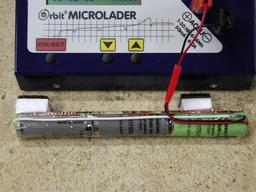 Today (Dec 27, 2001), I tried a 3-cell 830mAh
Lithium Ion battery pack that I made from two Qualcomm phone battery
packs. The pack weighs 78 grams as shown (connect to my Orbit
charger). The airplane was Tiny, sporting a
DC1717 motor with the 11:1 gearbox and a 28cm x 12 cm carbon fiber
prop. This was a great performer! Lots of thrust and climb
capability. The 3-cell LiIon pack provides voltage similar to a
9-cell NiMh pack - just in the range Todd Long recommends for Tiny
with this motor and ESC. More informatin about the source of these
packs and how to modify an inexpensive LiIon charger for them is
available at Al's Electric
R/C Flying Page. A 2-cell pack is also an excellent source of
power for the M100 motor that I have on the And_Now airplane. Further
testing shows good performance with this battery. But now there is a
new LiIon battery available on the surplus market, described below.
Today (Dec 27, 2001), I tried a 3-cell 830mAh
Lithium Ion battery pack that I made from two Qualcomm phone battery
packs. The pack weighs 78 grams as shown (connect to my Orbit
charger). The airplane was Tiny, sporting a
DC1717 motor with the 11:1 gearbox and a 28cm x 12 cm carbon fiber
prop. This was a great performer! Lots of thrust and climb
capability. The 3-cell LiIon pack provides voltage similar to a
9-cell NiMh pack - just in the range Todd Long recommends for Tiny
with this motor and ESC. More informatin about the source of these
packs and how to modify an inexpensive LiIon charger for them is
available at Al's Electric
R/C Flying Page. A 2-cell pack is also an excellent source of
power for the M100 motor that I have on the And_Now airplane. Further
testing shows good performance with this battery. But now there is a
new LiIon battery available on the surplus market, described below.
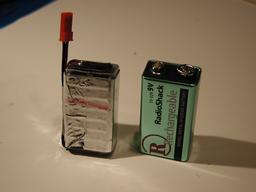 Another battery I tested today (Dec 27, 2001) was a
Radio Shack 150mAh pack normally sold as a 9-volt rechargable battery.
With the case, it weighs 43 grams and removing the case reduces the
weight to 36 grams (which includes the connector). Tiny flies ok with
this battery, but the battery doesn't generate enough power for
aerobatics with the 11:1 gearbox on the DC1717 motor. By comparison,
Batteries America has 150mAh
batteries that weigh 3.9 grams each, or 26 grams (.95 oz) for a 7-cell
pack. Add the weight of a connector and wires and packing tape, and
the resulting 7-cell pack is probably around 30 grams (1.05 oz). The
9-volt cells from Batteries America weigh the same as the Radio Shack
cells, so there must be something more efficient about round cells vs
rectangular cells.
Another battery I tested today (Dec 27, 2001) was a
Radio Shack 150mAh pack normally sold as a 9-volt rechargable battery.
With the case, it weighs 43 grams and removing the case reduces the
weight to 36 grams (which includes the connector). Tiny flies ok with
this battery, but the battery doesn't generate enough power for
aerobatics with the 11:1 gearbox on the DC1717 motor. By comparison,
Batteries America has 150mAh
batteries that weigh 3.9 grams each, or 26 grams (.95 oz) for a 7-cell
pack. Add the weight of a connector and wires and packing tape, and
the resulting 7-cell pack is probably around 30 grams (1.05 oz). The
9-volt cells from Batteries America weigh the same as the Radio Shack
cells, so there must be something more efficient about round cells vs
rectangular cells.
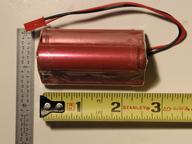 Other Lithium Ion batteries I've found are the 18650 batteries from
cell phone battery packs sold by Electronic Goldmine. I use
either a 2-cell or 3-cell pack (see the pink colored cells in the
photo) in the Firefly airplane driving an M100 motor with a 3-amp
static current draw. These cells have a capacity of 1600mAh.
Other Lithium Ion batteries I've found are the 18650 batteries from
cell phone battery packs sold by Electronic Goldmine. I use
either a 2-cell or 3-cell pack (see the pink colored cells in the
photo) in the Firefly airplane driving an M100 motor with a 3-amp
static current draw. These cells have a capacity of 1600mAh.
I have begun using 550mAh Lithium Ion batteries I found from another
thread on EZonemag.com. They
are the Neopoint cell phone packs found on Ebay for under $4.00 per
pack (search for 'Neopoint battery' on Ebay). There are two cells per
pack as shown in the photo (two flat cells end-to-end). I've been
using these 2-cell packs on the Tiger Moth with GWS DX-A motor and 9x7
prop and 3-cell packs on the House Fly. They are a little small for
use on the And_Now with the M100 motor. A 3-cell packs also works well
with the DC1717 motor on the Tiny.

There are some very high capacity Lithium Ion batteries available, but I have not seen them on the market. Basic info is available from SaftBatteries.
Another cell type that's recently gained attention is Kokam Lithium Polymer cells, sold by FMA Direct. These cells are Lithium Polymer and have exceptional current handling capabilities - about 3C continuous and 4-5C for short bursts. In addition, they are safer in that they are packaged in plastic shells which simply expand and emit some gas if overcharged. That's much safer than the explosive Lithium Ion cells. Kokam has done extensive testing to make sure that the cells don't have any bad failure modes. They've even driven nails through them. The Kokam LiPoly cells come in the following capacities (mAh): 45, 145, 560, 1020, 1575, 2070, and 3270. A 7500mAh cell is in the near future. A trick to obtaining high current is to build two packs, use the packs in parallel with a Y cable, then charge the packs independently (or in series).
I started using the JST/BEC connectors (see photos above) because
that's what is used on the GWS equipment that came with my Tiger
Moth. Since then, I've discovered another connector that works much
better: the 2-pin DEANS micro connector (DEANS part # 1222 - see
photo).  Don't
confuse this with the 2-pin Ultra connector, which is much larger.
These connectors have much less resistance than the JST/BEC connectors
I was using. I learned this when I was charging a pack at 2A and
discovered that the connector was noticeably warm. Further testing
showed that the voltage drop and power loss was not just on one pack.
Since then, I've been switching my packs to the DEANS connectors.
I'll eventually switch to these connectors for all my equipment that
uses less than 4A. They may be purchased from HeliHobby.com (look under
Accessories).
Don't
confuse this with the 2-pin Ultra connector, which is much larger.
These connectors have much less resistance than the JST/BEC connectors
I was using. I learned this when I was charging a pack at 2A and
discovered that the connector was noticeably warm. Further testing
showed that the voltage drop and power loss was not just on one pack.
Since then, I've been switching my packs to the DEANS connectors.
I'll eventually switch to these connectors for all my equipment that
uses less than 4A. They may be purchased from HeliHobby.com (look under
Accessories).